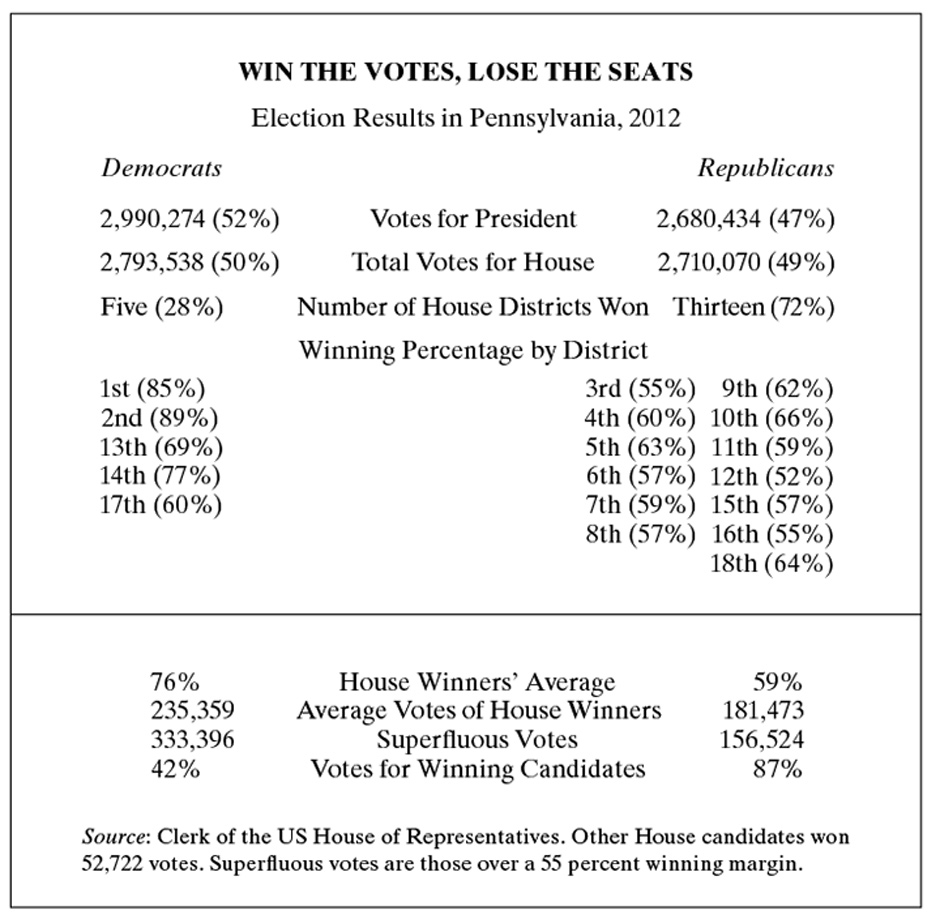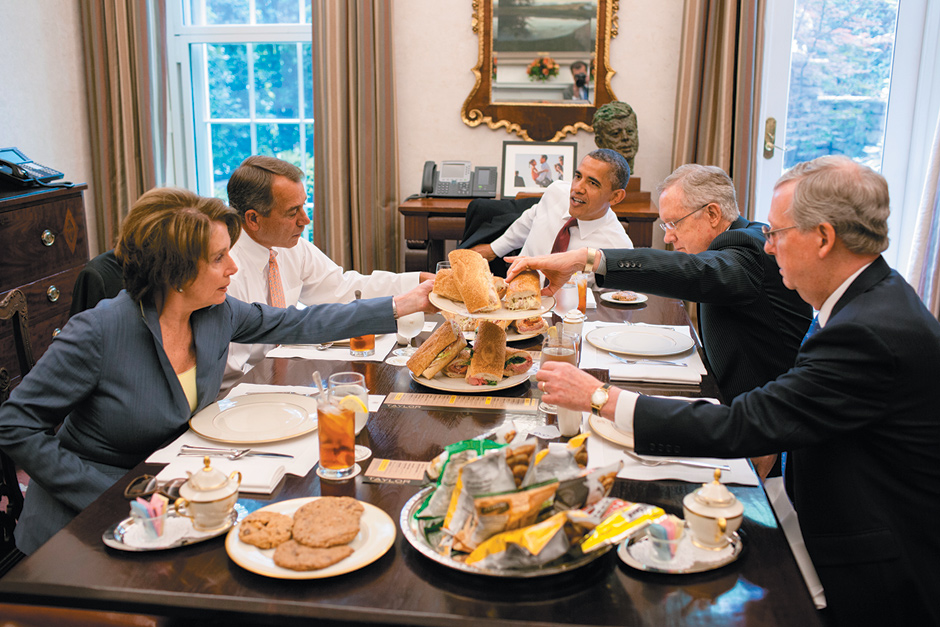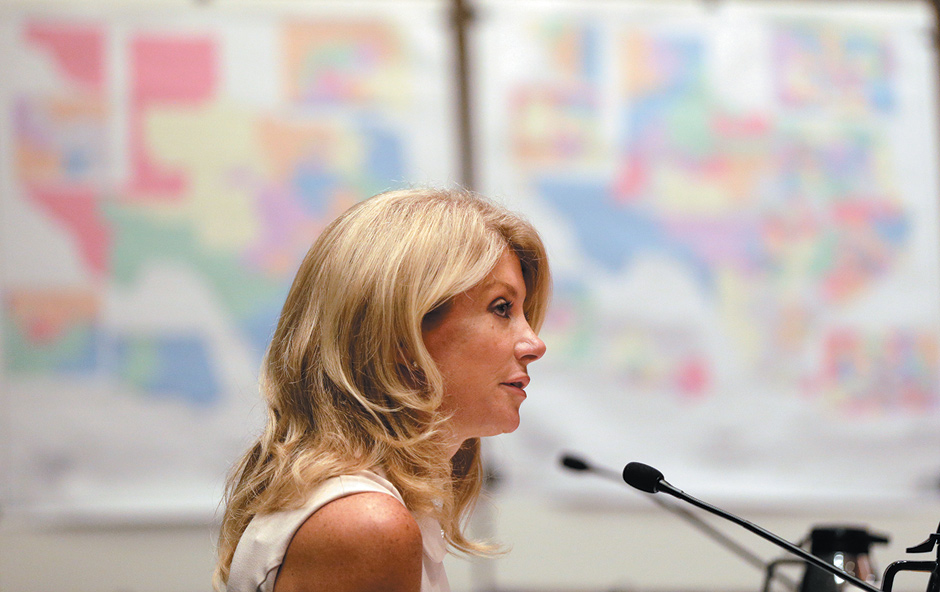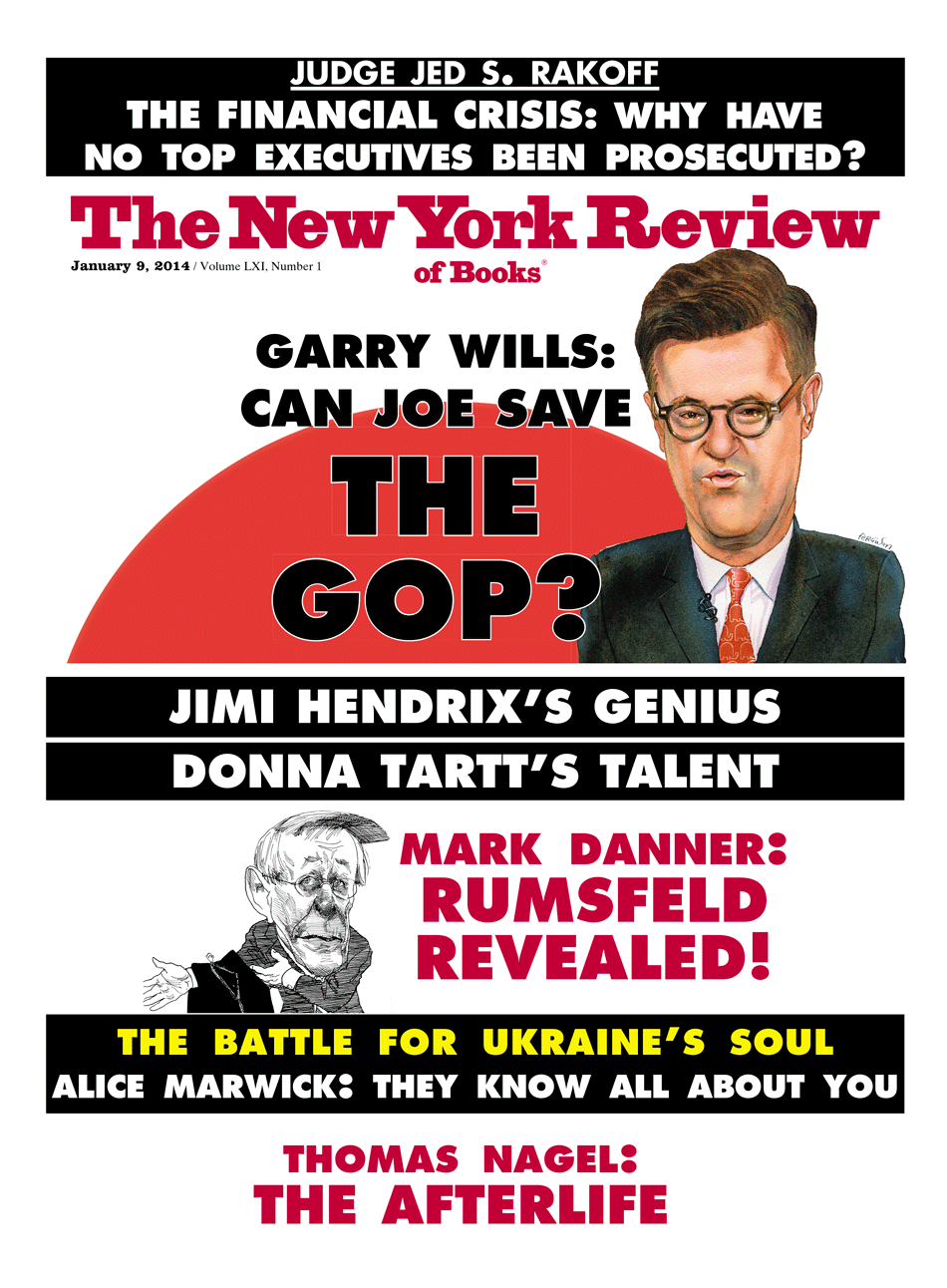Here’s our current political situation:
• A Democratic president has twice won the popular vote, both times by comfortable margins.
• In the Senate, Democrats (with two independents) hold 55 percent of the seats, receiving nearly that share of the votes in their most recent races.
• Republican now have a thirty-one-seat edge in the House of Representatives, although Democrats together won more votes than Republicans in the 2012 House races.
• Republican-appointed justices freely use their 5–4 majority on the Supreme Court, with only one of them an occasional moderate.
• While Obama twice carried Florida, Michigan, Ohio, Pennsylvania, and Wisconsin, in 2010 those states elected GOP governors and legislatures.
Can the Democrats muster enough votes to win back both the House of Representatives and state governments where the president has prevailed? Several books analyzing Barack Obama’s reelection should provide some clues. In 2012, he drew almost 66 million supporters to the polls. In theory, such a pool should be sufficient to turn the tide in state and district contests. Indeed, Republicans have done this with fewer adherents. Why can’t the Democrats?
1.
Double Down brings to mind CBS’s You Are There, which placed audiences at, for example, the signing of the Magna Carta and the storming of the Bastille. Mark Halperin and John Heilemann describe a “secret retreat” for GOP donors in Bachelor Gulch, Colorado, and then George Clooney’s “star-studded” party for Obama that raised a record $15 million. Their book is heralded as an inside story of the 2012 election, centering on “back rooms and closed-door meetings,” where aides and advisers and consultants lose their tempers and stumble for lack of sleep. Much is familiar, but it is useful to recall Mitt Romney pleading that he’s “severely conservative.”
The authors try to give equal time to both parties, but the real drama is in the GOP suites. If Halperin and Heilemann weren’t in all those closed rooms themselves, they’ve spoken with people who were, most of whom apparently have total recall. To maintain suspense, the election is depicted as a dead heat until Obama wins it. Hence nearly an entire chapter suggests that Obama’s listless Denver debate could have lost him the race. But it also suggests that Romney—“the most gaffe-prone nominee in anyone’s memory”—was doomed from the start. If he had not made his quip about 47 percent of the nation, he might well have said something equally ruinous.
While Double Down makes for intriguing reading, it tells us little about the election. It’s like rendering the Battle of Waterloo from—and never leaving—the generals’ tents. Missing are the 130 million Americans who turned out to vote. And equally important, the 92 million who didn’t. At the least, we’d like to know why an ample majority chose to “double down” with Obama. How far, if at all, were they swayed by all that backroom strategizing? About the only contact the authors make with the public is through polls. Thus they report that many named Obama’s handling of Hurricane Sandy as “the most important factor in their decision” on which way to vote. Perhaps that’s what they said. But we also learn that over 85 percent had made their choice a month or more before Sandy struck in late October. The acute New York Times analyst Nate Silver, whom the authors never cite, made that clear in late September.
John Sides and Lynn Vavreck, who teach political science at George Washington University and UCLA, contend that Barack Obama’s reelection was assured even before the campaigns began. Indeed, the die may have been cast a full year before the actual election. Their book The Gamble—a title never fully explained—argues that a complex of “structural conditions” meant that Mitt Romney never had a chance. One such condition was the president’s “unexpected popularity,” with their surveys showing that voters saw him as “warm, likable, and empathetic.” Another was “partisan polarization,” which aided Obama since the most intensely polarized voters were largely right-wing Republicans. In addition a “slow recovery” was underway, with people still blaming George W. Bush for the state of the economy.
These and other findings, the authors say, are based on “a rich research tradition in political science.” Perhaps for that reason, they confine their analysis to factors that can be quantified, like economic indicators, poll responses, and advertising expenditures. Their findings show that the Obama campaign had 786 field offices, while Romney’s opened only 284. They write that 187 counties had at least one Obama storefront and none for Romney. When hard numbers aren’t available, they are forced to say, for example, “we do not know how many voters were contacted by either campaign.” Nor are there signs that they visited any of the counties they’ve counted, or chatted with any of the people on voting lines.
Advertisement
They conclude that Obama’s “field operation—at least as we have measured it here—likely did not decide the election.” Their reasoning is that “many people who vote in presidential elections do so out of habit,” so “they do not need to be contacted by a volunteer.” These are curious conclusions. What put Obama over the top in 2008 was a huge grassroots effort, based on locating people who don’t usually vote and personally urging them to register, often by e-mail and texting. Of course, certain ethnic groups were targeted; but equally crucial were young people, who ordinarily remain aloof from politics. These lists were updated for 2012, and the Obama strategists were well aware that the people on them would need reminding.
Sides and Vavreck also conclude that the costly campaigns “largely neutralized each other’s efforts.” They arrive at this view partly by comparing advertising budgets with electoral results. What they don’t try to measure was the Democrats’ edge in important categories of voters. It’s only a start to note that in both years, voters under thirty went overwhelmingly for Obama. More critically, his youthful staffers were more digitally savvy and willing to canvass in unfamiliar neighborhoods. It’s harder to visualize comparable young Republicans ringing blue-collar doorbells.
2.
Alan Abramowitz, a prolific political scientist at Emory University, says he has data showing that not only far-out legislators and talk show hosts espouse extreme views. In The Polarized Public? he concludes that ordinary voters are also “deeply divided by race, by ideology, by religious beliefs and moral values, and by geography.” If his title is posed as a question, he draws an answer from post-election polls and statistical analyses of these and other sources. They appear to reveal that “ideological orientations” have reached the “mass level” in the electorate. In this reading, we no longer have a graduated political spectrum, but—to represent the right wing and the left wing—something more like a heavy barbell, with its weights well apart and equally balanced.
Several tables depict how “rank-and-file Republicans have been following their party’s leaders to the right.” They strongly oppose gay marriage and health care reform, and also rank high in “racial resentment.” (But they turn out to be more moderate on abortion.) On race, we are told, they tend to agree with statements like these:
If blacks would only try harder they could be just as well off as whites.
Blacks are demanding too much from the rest of society. 1
Abramowitz says that Obama’s victories may have led to “activating racial fears.” Drawing on his analysis of data from the American National Election Studies (ANES), based on interviews with over a thousand respondents who had exited the polls, he writes:
These results clearly show that the rise of the Tea Party movement was a direct result of the growing racial and ideological polarization of the American electorate. The Tea Party drew its support very disproportionately from Republican identifiers who were white, conservative, and very upset about the presence of a black man in the White House—a black man whose supporters looked very different from themselves.
Of course, Republican politicians deny racist views and point admiringly to Clarence Thomas and Condoleezza Rice and to the appointment of a black senator in South Carolina. Abramowitz’s analysis seems to me suggestive; but we need more evidence if we are to know just how much of the antipathy to Obama is based on his being black and how much is owing to other causes, such as the personal manner that some voters associate with his years at Harvard and the University of Chicago.
But who and where are the ideology-driven Democrats who ostensibly balance the GOP end of the barbell? Inexplicably, The Polarized Public? provides no data on the spread and intensity of their views. Of course, all sorts of issues engage Democrats, ranging from reproductive rights and the environment to unemployment and distribution of income. While these positions are sincerely held, they do not match the fervor Republicans bring to taxes, guns, and abortion, often heightened by religious teachings. On the whole, that Democrats bear their ideological convictions more lightly has become a fact of American politics.
Halperin and Heilemann’s Double Down says little about the role of money in 2012, other than Romney’s difficulties in raising it. Sides and Vavreck’s The Gamble dwells mainly on the sums spent on advertising. I found this a bit odd, since 2012 was the first presidential contest since the Citizens United decision, in which the Roberts court held that corporate entities have the same rights of expression as citizens. Hence there has been widespread concern over corporate giving, which has also been abetted by provisions allowing donors to conceal their names. Charles and David Koch’s major conduit doled out $236 million in 2011–2012, and its budget of $256 million dwarfed that of the Chamber of Commerce or the National Rifle Association. Most of the new cash comes from self-made figures like Sheldon Adelson, who bet heavily on Newt Gingrich. Others are owners of family-held enterprises—like Harold Simmons, Arthur Pope, and Joseph Ricketts—who rarely make headlines, if only because they focus on state and district contests, and Republican primaries in which turnout is low.
Advertisement
Yet despite looser reins, all corporations together gave only $75 million of their own funds directly to candidates. Most of them must appeal to consumers and don’t want to be tagged with partisan positions.2 Mark Mizruchi, in The Fracturing of the American Corporate Elite, explains why corporations have become less openly political. While he doesn’t cast the executives of the past as industrial statesmen, he argues they had “a sense of responsibility” to “attend to the well-being of the broader population.”
Mizruchi makes a convincing case. In 1966, Lyndon Johnson was promoting a broad urban housing bill. The Senate had passed it; but it was stalled by “attacks by Republicans in the House.” Johnson sought outside support, and got it from a widely publicized open letter that declared the bill to be “the single most important domestic proposal before the Congress.” It was signed and circulated by twenty-two leading businessmen, among them the heads of General Electric, IBM, American Express, Lehman Brothers, R.H. Macy, and the Chase Manhattan Bank. The bill was enacted soon thereafter.
It’s not easy to imagine this kind of concerted action today on broad-based issues like health care or immigration. Of course, corporations are still deeply involved in politics. But their spending is now more finely tuned, concentrating on lobbying, trade associations, and revolving doors at public agencies. The Fortune 500 are more prosperous than ever; but their current chiefs have little leverage over what for close to a century was literally their party. Indeed, with corporate bailouts now a target of Tea Party criticism, they have fewer platforms for responding.
3.
If we are to fathom the power and demeanor of the current House of Representatives, two numbers are central to the story:
59,214,910
57,622,827
These are the respective electoral totals for Democratic and Republican candidates for that chamber in 2012. Yet Democrats ended with only 201 of the 435 seats, an easily ignored minority. House Republicans are in no way diffident about holding sway with a minority of the votes. As heirs to Alexander Hamilton, they see no reason to heed the “mass of the people” who “seldom judge or determine right.” In their view, the 47 percent described by Romney as freeloaders don’t deserve to have their ballots carry weight, any more than they deserve Medicaid coverage. Indeed, an avowed GOP strategy is to reduce the electorate, deploying a modern variant of the poll tax. In more than a few states, anyone lacking a driver’s license or a passport will have to unearth a decades-old birth certificate in order to be eligible to vote.
The GOP used its statehouse victories in 2010 to make the House its permanent preserve, regardless of overall totals. The method used was careful gerrymandering—the old art of massaging political maps, now augmented by computer algorithms. Pennsylvania is an apt example. In 2012, Obama carried the state, and the Democratic candidates for the state’s eighteen House seats got a de facto majority—50.3 percent. Yet despite that margin, they secured only five seats to Republicans’ thirteen. The figures in the table below show how it happened. In the five districts where Democrats were allowed to win, they had majorities far larger than needed for even an ordinary safe seat. Thus only 42 percent of all Democrats ultimately voted for winners, whereas 87 percent of Republicans did so.

The statistics of gerrymandering should receive more attention that they get. Pennsylvania’s electoral map uses 9,233 local precincts, each with about 600 voters, as potential pieces for possible districts. Here computers are needed, since it’s not feasible to carve out districts from 9,233 subdivisions using pencil and paper. Useful numbers are on hand for each precinct: party registrations, how people voted in the past, along with economic and social data from overlapping census tracts. While not all voters behave predictably, enough do so that a party with 47 percent of the votes secures 72 percent of the seats.
Nor is Pennsylvania exceptional. In 2012 House races, eighty-two Democrats won with margins over 70 percent, but only forty-six Republicans did so.3 Another tactic is to ensure that the GOP’s own seats stay relatively safe. The table shows almost all GOP districts having ample margins, with only one under 55 percent. For Democrats to break up this bloc will require an extraordinary effort. By my count, in Pennsylvania they will need to rally 185,384 new voters in counties where their support is already quite sparse. The same kind of recruiting will be needed in a dozen other states. Indeed, the Democrats’ demography is such that they will need well over a majority to get their numerical share of district-based seats.4
Figures from The Almanac of American Politics reveal, perhaps surprisingly, that the Senate is much more evenly proportioned. Its fifty-five Democrats, including the two independents who caucus with them, won their seats with 52.5 percent of the votes in six years of Senate races. Of course, states can’t be gerrymandered as House districts can. Even so, their varied sizes can produce similar effects: Democratic senators who won averaged 1,480,907 votes, while Republicans got in with 1,015,460.
4.
Halperin and Heilemann call 2008 and 2012 “game change” elections, by which they mean departures from the practices of the past. In particular, Obama’s campaigns relied on enlisting and retaining new blocs of voters, especially people who had never gone to the polls before. The campaign’s demographics team parsed data in creative ways, correlating the preferences of cable viewers with the partisan “likes” of Facebook friends. His victories also showed that over half of voting Americans—even if not a majority of whites—were ready for a president of African origin. But what needs to be added, as Halperin and Heilemann do not, is that those who rallied twice to put Obama over the top were doing it chiefly for him, and not so much for partisan or even strictly political reasons. His successes, with comfortable margins, have been more like personal plebiscites.
The real political test came two years after his first victory. Of course, midterm elections always draw fewer voters. And as Elizabeth Drew has shown in these pages, they tend to “reward intensity.”5 But the 2010 turnout was especially skewed. By my count, among voters who had supported John McCain in 2008, 74 percent showed up, while only 56 percent of Obama’s backers did. In real numbers, of the 69.5 million who took the time and trouble in 2008 to vote for Obama, 30.6 million did not turn out again on November 2, 2010. So it’s no wonder that so many House seats and state capitals fell into GOP hands. Yet it wasn’t that so many Obama voters stayed home because they regretted their choice. The 2012 tally showed that wasn’t so.
The obstinacy of the Republican House of Representatives has been the biggest blight on Barack Obama’s tenure. If the GOP keeps control of that chamber in 2014, this will mean six successive years of political paralysis and a presidency largely shorn of domestic powers. Even with the stakes this high, House contests are all but invisible to the majority of Americans, who only vote—if they do—every fourth year.
At this point, it’s not possible to predict which issues will count the most in November 2014, although they will include Obama’s broken promise on people being able to keep their health insurance and his failure to launch the Affordable Care Act on the Web on time, as well as the rate of employment and the pervasiveness of surveillance. Current polls show that Republicans aren’t popular. But those sentiments may derive more from a shutdown of government that may soon be forgotten than from policy positions.
On the Democratic side, the problem is that the party itself has a relatively small loyal core of voters who will always turn out when needed. But many who voted for Obama haven’t embraced his party, let alone seen it as integral to their identity, although they vote the full column once in the booth. Still, most are not willing to make the effort to vote in off-year elections. Nationally, Republicans may be the minority party, but politics is a more important part of their lives, and not just for the Tea Party fringe. A small but telling fact from a Pew survey: more Republicans can name their elected officials.
For Democrats to prevail in 2014, record numbers of Obama’s 2012 supporters will have to be given reasons to bestir themselves, despite his not being on the ballot. They will be asked to vote for a party rather than a personality, with little time for the Democrats to make a convincing case, especially if the new health care system’s mishaps haven’t all been resolved. Then they must be urged to wait on line to vote for state or district candidates whose names may be unfamiliar, not to mention their platforms or records. Before that, many will have to search out a Bureau of Motor Vehicles office and properly fill in forms for an identity card.
In the past, it would be broadcast that the president supported local candidates, and they would be beholden to him, on the premise that his presence and his support would bolster the entire ballot. That’s less true today. Few Democratic candidates, especially those courting erstwhile Republicans, want posters with Obama’s arm on their shoulder. It may seem paradoxical to stay distant from a president who did well nationally. Yet the fact is that of the twenty-two House districts where Democrats came closest to winning in 2012, Obama carried only six. In marginal terrain, Democrats win largely on their own, not because of the party or the president.
As recently as 2006, the reverse happened. George W. Bush won handily over John Kerry in 2004. Yet two years later enough Democrats turned out to transform their House delegation from 202 seats—a minority—to 233 seats—a majority. At issue of course was the war in Iraq. But something equally instructive was going on. Howard Dean, then chairman of the Democratic National Committee, insisted that every district in the country be contested, regardless of the odds. The aim was to find attractive candidates with local roots who could entice Republicans into giving a Democrat a try. Gabrielle Giffords in Arizona did just that, as has Terry McAuliffe in the Virginia governor’s race, and Charlie Crist might in Florida. Wendy Davis may not win the Texas governor’s race, but by being on the ballot she could lift the turnout for Democrats in House races. With or without the president’s mantle, contenders like these could give the party a lift nationally. Dean would even show the flag in the twenty-three GOP districts that are so safe that no Democrat ran in 2012.6
From his first day in office, Barack Obama made reconstruction of the nation’s health services his highest priority. The concessions that had to be made for so sweeping a plan are well known, notably abandoning a public option and negotiating on drug prices. What should be added is that the Affordable Care Act would never be politically popular. Most regular voters were and are fairly content with their coverage, either through Medicare or their employer, and would at best benefit marginally from the new provisions. So from their standpoint, the law was largely for other people, most of them lower on the social scale. Moreover, some of the uninsured are not enthusiastic about the law intended to help them. Still, the act will be his finest legacy as a leader. He asked Americans to support something huge and new, not for the direct benefit of most of them, but because it would make their country a better place. That so many have stayed with him on this commitment is also to their credit.
-
1
While Abramowitz used these statements in his survey, they do not appear in his book. They may be found in P.J. Henry and David O. Sears, “The Symbolic Racism 2000 Scale,” Political Psychology, Vol. 23, No. 2 (June 2002). ↩
-
2
See Eduardo Porter’s acute article, “Business Losing Clout in a GOP Moving Right,” The New York Times, September 4, 2013. ↩
-
3
Kyle Kondik, “Republicans Hold the Line: 2012’s National House Contest,” in Barack Obama and the New America, edited by Larry J. Sabato (Rowman and Littlefield, 2013). ↩
-
4
Sam Wang estimates that Democrats will need an almost unprecedented seven-point edge in overall House votes to win it back in 2014. See his “The Great Gerrymander of 2012,” The New York Times, February 2, 2013. ↩
-
5
“The Stranglehold on Our Politics,” The New York Review, September 26, 2013. ↩
-
6
I had several conversations with Howard Dean while writing this review. ↩




